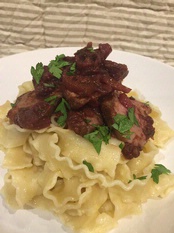WINE WITH…Pasta with Duck Breasts in Red Wine Sauce
We probably all know the difference between lasagna and linguine, or between ravioli and rigatoni, but could you tell cavatappi from casarecce, or cappalletti from campanelle? According to
Italy Magazine, from agnolotti to ziti the world is blessed with some 350 different pasta shapes. While there are many

reasons for this abundance, including geographic variations, the fact is that the general shape of each type of pasta determines which sort of sauce is best suited to it. There are no hard and fast rules here, but in general, thin pastas (angel hair and spaghettini for example) adapt best to light, thin sauces, while flat ribbon-like pasta such as fettucine, pappardelle, and tagliatelli are designed for thicker, meaty sauces. Tubular pastas--orecchiette, penne, rigatoni--are perfect for capturing medium weight sauces, and tiny pastas along the lines of annelini, star-shaped stellini, and ditalini are commonly used in soups.
Most pasta dishes, we think, taste best when the sauce is mixed in with the pasta. (In fact, many chefs give a pasta dish more intense flavor by stirring the still-simmering sauce into slightly undercooked pasta, which allows the sauce to cook a little into the noodles.) In this dish, however, which incorporates duck breast into a thick, rich tomato sauce, we wanted the sauce to be the star, while the pasta serves as the all-important supporting actor. To achieve this, we topped the pasta with the sauce rather than tossing the two elements together.
Pasta With Duck Breasts in Red Wine Sauce
Serves 4
We used malfada, a flat, ribbon-like pasta with wavy edges that looks somewhat like narrow lasagna noodles. Other good pasta shapes for this dish would be papparddelle, tagliatelli, or fettuccine.
2 duck breasts
1 cup chopped onion
2-3 cloves garlic, chopped
1 teaspoon each thyme, oregano, rosemary
2 cups roughly chopped tomatoes (we peeled and seeded ours, but this isn’t absolutely necessary)
salt and pepper
red pepper flakes
2/3 cup red wine
½ pound pasta
2 tablespoons olive oil or more
1/2 cup grated parmesan
minced parsley for garnish (optional)
To cook the duck breasts, pat them dry and score their skin with a sharp knife at ¼ inch intervals, then score in the other direction to make a crisscross pattern (try not to cut into the flesh). Place the breasts, skin-side down, in a cold cast iron skillet or other heavy pan. Cook over low to medium-low heat, pressing down on the breasts with a spatula from time to time until the fat has rendered and the skin is crispy and brown (this should take about 8-10 minutes). Turn the breasts over and cook another 3-5 minutes. Remove the breasts and let them rest until you are ready to finish the sauce. Reserve 1 tablespoon of the rendered duck fat, but save the rest of it for later use in another recipe such as sautéed potatoes or Brussels sprouts.
Wipe out the skillet and add the reserved tablespoon of duck fat. Add the onion and sauté it for a few minutes or until it has softened and is just beginning to color. Stir in the garlic and herbs and continue cooking over medium heat for another minute or two, then add the tomatoes. Season the mixture and continue simmering it, uncovered, for about 5 minutes. Add the wine and cook over medium-high heat about 20-30 minutes, or until the mixture has darkened and thickened.
Meanwhile, peel the duck skin off the breasts. (If you wish to garnish the finished dish with crispy duck skin, cut it in very small pieces and reserve it until ready to serve.) Slice the duck meat in thin pieces on the bias.
About 10-12 minutes before serving, cook the pasta according to package directions. Reheat the tomato mixture, then stir in the duck slices and simmer for a few minutes to reheat them (do not let the duck overcook). When the pasta is done, drain it and then toss it with the olive oil and Parmesan. Divide the pasta among 4 serving plates and top each with the duck sauce. Garnish with minced parsley if you wish.
* * *
This is a rich dish so you will want to pour a rich red wine with it. Choose one with a good amount of acidity so that it won’t seem flabby when set against the tomato-rich sauce. Earthy elements can help the match gain complexity, but a fruit-filled red can do equally well. Just don’t choose something too light or subtle.